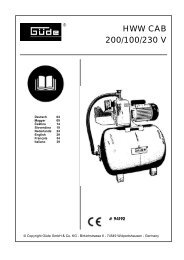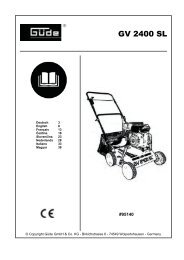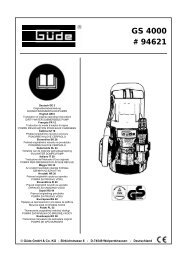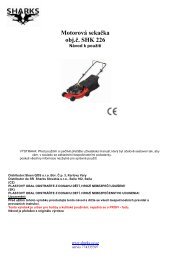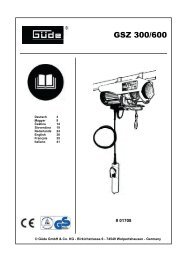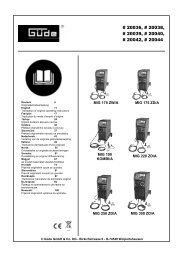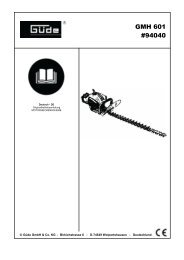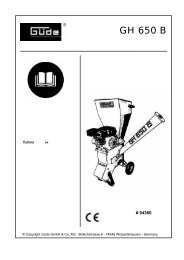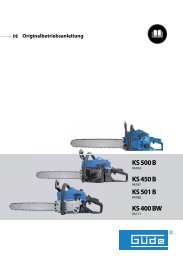MIG 155/6W
MIG 155/6W
MIG 155/6W
Create successful ePaper yourself
Turn your PDF publications into a flip-book with our unique Google optimized e-Paper software.
The zone to be welded should be rid of rust and varnish. The burner is selected according to the type of material. It is<br />
recommended to try the strength of current on a defective piece first.<br />
Faults - Causes - Elimination<br />
Fault Cause Elimination<br />
Welding current drops<br />
out<br />
Welding current not<br />
available at all.<br />
Protective power switch<br />
or RCD fell out<br />
Welding current is not<br />
available .<br />
Wire feeding motor does<br />
not operate, pilot lamp is<br />
on.<br />
Wire feeding motor does<br />
not work, Pulleys rotate.<br />
Wire feeding is irregular.<br />
Electric arc burns in<br />
unstable way.<br />
Welded joint is porous.<br />
Welding wire stops in<br />
proximity of stream<br />
nozzles<br />
Welding pressure is<br />
irregular<br />
Too weak penetration<br />
Too strong penetration<br />
1. – Protection against excessive temperature<br />
fell out due to overload.<br />
1. Protection against excessive temperature will<br />
perform automatic reset after cooling the transformer<br />
(approx. after 10 minutes, take care of ED!)<br />
1. Mains fuse fell out 1. Let the fuse checked<br />
2. Turn the protective output power switch on<br />
3. Turn the RCD on<br />
1. Bad contact between grounding clamp and<br />
welded part<br />
2. Rupture in grounding cable or grounding line<br />
3. Rupture in burner line<br />
1. Fuse is burnt.<br />
2. Toothed rim is faulty or blocked.<br />
3. Motor is defective.<br />
1. The pressure to the pulley is not adjusted<br />
properly.<br />
2. There is dirt, dust etc. on the stream nozzle of<br />
the burner.<br />
3. Gas nozzle is defective.<br />
4. The wire is warped.<br />
5. Inner tube of the wire guide is dirty or<br />
damaged.<br />
1. Dirt at the wire guide. Gas nozzle is worn-out<br />
or defective.<br />
2. Gas nozzle is clogged.<br />
3. An obstacle restrains the wire feeding pulleys<br />
guiding.<br />
4. Wire feeding pulleys guiding has deformed.<br />
5. Improper tension of the wire<br />
1. Improper wire speed adjustment<br />
2. Dirt at the welded place.<br />
3. Gas nozzle is worn-out or defective.<br />
1. No gas<br />
2. Nozzle holder is blocked<br />
3. Material is rusty or damp<br />
4. Burner is too far or you hold it at incorrect<br />
angle towards the point being welded.<br />
1. Stream nozzle is worn-out.<br />
2. Welding wire is warped.<br />
3. Wire feeding speed is too low.<br />
1. Clean and grind the welded area and surface of the<br />
part.<br />
2. Repair or replace the grounding cable.<br />
3. Repair or replace the burner.<br />
1. Replace the 2 A-fuse.<br />
2. Replace the toothed rim.<br />
3. Replace the motor (contact customer service).<br />
1. Adjust the pressure to pulleys correctly.<br />
2. Clean the machine contact tube. Use an air<br />
compressor to do so, in case of heavy contamination<br />
replace the contact tube<br />
3. Replace the gas nozzle and check the tip.<br />
4. Check the pulley pressure and adjust it properly if<br />
necessary,<br />
5. Clean with compressed air and let the hose replaced<br />
if necessary.<br />
1. Clean the machine wire guide using an air<br />
compressor.<br />
2. Replace the gas nozzle or contact tube.<br />
3. Clean or replace the gas nozzle.<br />
4. Clean the wire feeding pulleys.<br />
5. Replace the wire feeding pulleys.<br />
6. Adjust the wire tension properly.<br />
1. Adjust the wire speed according to recommended<br />
systems.<br />
2. Clean or polish the welded surface.<br />
3. Replace the gas nozzle and check the tip.<br />
1. Open the gas and adjust the gas intake flow.<br />
2. Clean or replace the gas nozzle.<br />
3. Properly treat the place of welding or increase the<br />
gas inflow.<br />
4. Clean or polish the material.<br />
5. Distance between the gas nozzle and processed<br />
piece must be 8-10 mm and the hose should be held<br />
at an angle of 30°.<br />
6. Check the rubber hose, connection and hose set<br />
assembly. – Depress the gas nozzle into proper<br />
position.<br />
1. Replace the stream nozzle.<br />
2. Check the pulley tension pressure.<br />
3. Follow the instructions for wire feeding speed.<br />
1. Welding wire blocked on the coil 1. Check the pressure of pulley tension and adjust if<br />
necessary.<br />
1. Welding current too weak<br />
1. Increase the welding current and wire feeding.<br />
2. Electric arc too long<br />
2. The hose should be held near the piece being<br />
1. Welding current too high<br />
2. Wire feeding speed too slow<br />
3. Improper distance of the burner from piece<br />
being processed<br />
Inspection and maintenance<br />
Maintenance of hose set<br />
processed.<br />
1. Reduce the welding current and wire feeding.<br />
2. The burner should be moved calmly and uniformly.<br />
3. The distance of the nozzle from the piece being<br />
processed must be 8-10 mm.<br />
Regular maintenance must be performed to ensure faultless function of hoses.<br />
Gas nozzle must be sprayed by protective spray for nozzles and remove sediments inside regularly.<br />
For this case the following steps should be performed (see Fig. 26):<br />
1. Remove the nozzle (1) by pulling it forward.<br />
20



